
Posts Tagged: salt damage
O NO, It's Raining
Thanks for the rains that leach the soils of accumulated salts and bring on new fresh growth. Or maybe not. When we apply irrigation water with salts which with few exceptions we do in irrigated agriculture, salts accumulate in the soil. They accumulate in a certain pattern depending on the type of irrigation and soil type. There's a strong tendency for drip and microsprinklers to form a pattern of salt accumulation near the margins of the wetted patterns. This pattern is stronger with drip because the source point is always pushing a front outward from the emission point. This pattern occurs with microsprinklers, as well, although not as strongly. These patterns continue to form and accumulate as long as there is no rainfall to evenly push the salt down below the root zone. The longer the period of no rain, the larger the salt concentration at the margin.
So the way water moves is generally down. It moves in a wetting front drawn by gravity. It moves laterally too, because of the attraction water has for the soil particles. It will move laterally more in a clay soil than in a sandy soil because there are more particles in a clay soil than a sand (actually more surfaces that hold water). It also carries salt with it. Wherever the water moves, the salt moves. The more rain, the more salt is moved down. The more rain, the deeper the salt is pushed.
The problem with rain, is that if there is not enough, the salt tends to move laterally. In this wet soil solution, the salt is moving from where it is concentrated, to where there is a lower one. And if there isn't enough rain to move that salt down, it just moves back along the salt gradient, back to where the water first came from…….towards the roots. And that salt may be at such a high concentration that it can cause plant damage.
We talk about effective rainfall. This is usually about a quarter of an inch of rain. This is the amount of water to do more than just wet the dust, it's the amount to move water into the root zone. It is also moving salts into the root zone which can be a real problem. A good rain will do more than wet the dust, it will also move the salts out of harm's way in the root zone. The amount of rain necessary to do this is going to depend on the salt accumulated and the soil texture. The more salt, the more rain needed. The finer the texture, the more rain.
So there is no good cookbook, other than you need enough. And the first rains of the year, watch out. This is often when there is the highest salt accumulation and in the fall when we have the most irregular rains. Small rain amounts that can move salt into the root zone. A rule of thumb is a minimum of a good one inch rain event or combined rain events of two inches in a short period is needed to dissolve and move the salts out of the avocado root zone's top 18 inches. The more the better.
If there is not enough rain……………The solution !!!!!!!! Run the irrigation system to make sure there is enough to move that salt down.
Get ready to irrigate with the first rains if they are insufficient for adequate leaching.
Also get ready for the first smell of rain - petrichor.
Petrichor (/'p?tr?k??r/) is the earthy scent produced when rain falls on dry soil. The word is constructed from Greek petra (π?τρα), meaning "stone", and ichor (?χ?ρ), the fluid that flows in the veins of the gods in Greek mythology.
The term was coined in 1964 by two Australian CSIRO researchers, Isabel Joy Bear and Richard G. Thomas, for an article in the journal Nature.[1][2] In the article, the authors describe how the smell derives from an oil exuded by certain plants during dry periods, whereupon it is absorbed by clay-based soils and rocks. During rain, the oil is released into the air along with another compound, geosmin, a metabolic by-product of certain actinobacteria, which is emitted by wet soil, producing the distinctive scent; ozone may also be present if there is lightning.[3] In a follow-up paper, Bear and Thomas (1965) showed that the oil retards seed germination and early plant growth.[4]
In 2015, scientists from the Massachusetts Institute of Technology (MIT) used high-speed cameras to record how the scent moves into the air.[5] The tests involved approximately 600 experiments on 28 different surfaces, including engineered materials and soil samples.[6] When a raindrop lands on a porous surface, air from the pores forms small bubbles, which float to the surface and release aerosols.[5] Such aerosols carry the scent, as well as bacteria and viruses from the soil.[5] Raindrops that move at a slower rate tend to produce more aerosols; this serves as an explanation for why the petrichor is more common after light rains.[5]
The human nose is extremely sensitive to geosmin and is able to detect it at concentrations as low as 5 parts per trillion.[7] Some scientists believe that humans appreciate the rain scent because ancestors may have relied on rainy weather for survival.
https://en.wikipedia.org/wiki/Petrichor
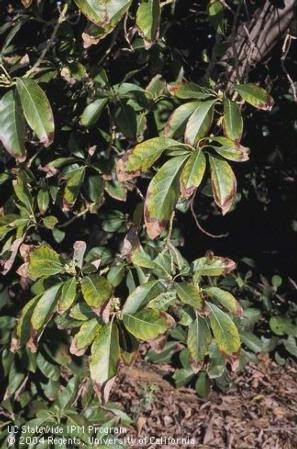
avocado salt damage
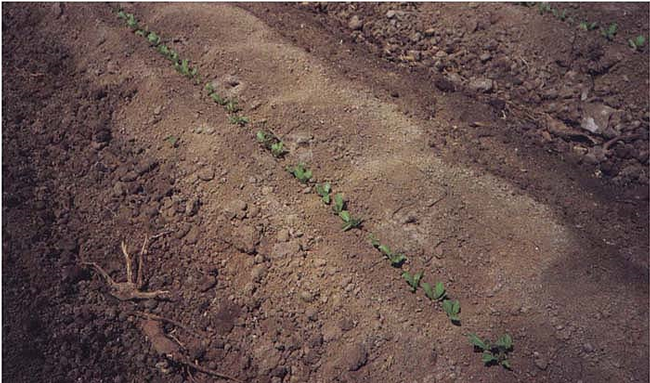
salt pattern
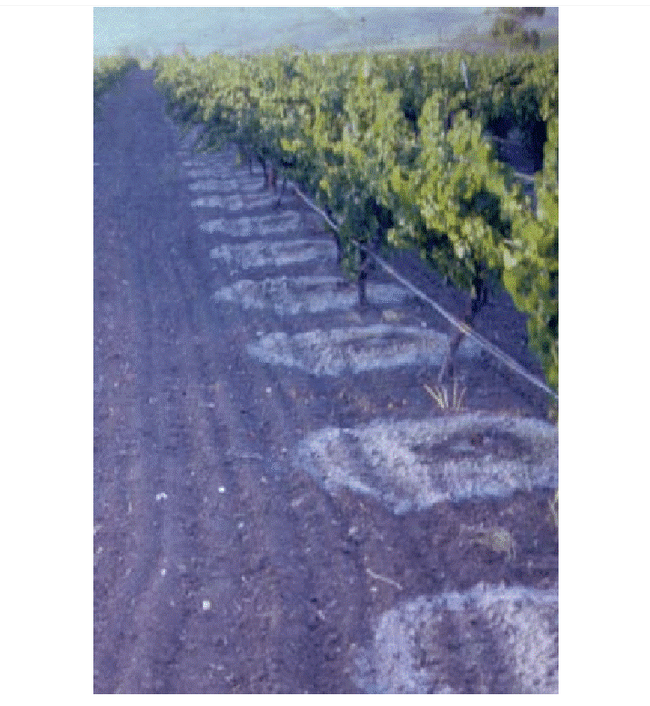
salt rings
A Small Amount of Rain Can Cause a Lot of Damage
Thanks for the rains that leach the soils of accumulated salts and bring on new fresh growth. Or maybe not. When we apply irrigation water with salts which with few exceptions we do in irrigated agriculture, salts accumulate in the soil. They accumulate in a certain pattern depending on the type of irrigation and soil type. There's a strong tendency for drip and microsprinklers to form a pattern of salt accumulation near the margins of the wetted patterns. This pattern is stronger with drip because the source point is always pushing a front outward from the emission point. This pattern occurs with microsprinklers, as well, although not as strongly. These patterns continue to form and accumulate as long as there is no rainfall to evenly push the salt down below the root zone. The longer the period of no rain, the larger the salt concentration at the margin.
So the way water moves is generally down. It moves in a wetting front drawn by gravity. It moves laterally too, because of the attraction water has for the soil particles. It will move laterally more in a clay soil than in a sandy soil because there are more particles in a clay soil than a sand (actually more surfaces that hold water). It also carries salt with it. Wherever the water moves, the salt moves. The more rain, the more salt is moved down. The more rain, the deeper the salt is pushed.
The problem with rain, is that if there is not enough, the salt tends to move laterally. In this wet soil solution, the salt is moving from where it is concentrated, to where there is a lower one. And if there isn't enough rain to move that salt down, it just moves back along the salt gradient, back to where the water first came from…….towards the roots. And that salt may be at such a high concentration that it can cause plant damage.
We talk about effective rainfall. This is usually about a quarter of an inch of rain. This is the amount of water to do more than just wet the dust, it's the amount to move water into the root zone. It is also moving salts into the root zone which can be a real problem. A good rain will do more than wet the dust, it will also move the salts out of harm's way in the root zone. The amount of rain necessary to do this going to depend on the salt accumulated and the soil texture. The more salt, the more rain needed. The finer the texture, the more rain. So there is no good cookbook, other than you need enough. And the first rains of the year, watch out. This is often when the highest salt accumulation and the most irregular the rains. Small amounts that can move salt into the root zone.
If there is not enough rain……………The solution !!!!!!!! Run the water to make sure there is enough to move that salt down. Crazy, but a few months ago we had just this situation. It was one of the last rains in the winter and it was not enough to move salts down, and within a week many avocados showed leaf damage. It was sad since we had all been wanting rain, and we wanted a good drenching.
So why am I bringing this up now? Well, the other night I woke up to rain, glorious rain. I enjoyed listening to it and then it stopped. I thought O NO, it's not enough. There are going to be problems. Well luckily most places didn't get and where it did, it was a dust settler. But it made me aware that with the first rains we might see this fall, growers should be on their guard.
Get ready to irrigate with the first rains if they are insufficient for adequate leaching.
Photo: Accumulated salts from irrigation water

soil salinity irrigation
Drought Induced Problems in Our Orchards
Drought Induced Problems in Our Orchards
Abiotic disorders are plant problems that are non-infective. They are not caused by an organism, but through their damage, they may bring on damage caused by organisms. Think of a tree hit by lightning or a tractor. The damage breaches the protective bark which allows fungi to start working on the damaged area, eventually leading to a decayed trunk. It was the mechanical damage, though that set the process in motion.
Too much or too little water can also predispose a plant to disease. Think of Phytophthora root rot or even asphyxiation that can come from waterlogging or too frequent irrigations.
Salinity Effects from Lack of Water
Lack of water and especially sufficient rainfall can lead to salinity and specific salts like boron, sodium and chloride accumulating in the root zone. This happens from a lack of leaching that removes native soil salts from the root zone or the salts from the previous salt-laden irrigation from the root zone. These salts cause their own kind of damage, but they can also predispose a tree to disorders, disease and invertebrate (insect and mite) damage.
Lack of water and salt accumulation act in a similar fashion. Soil salt acts in competition with roots for water. The more soil salt, the harder a tree needs to pull on water to get what it needs. The first symptom of lack of water or salt accumulation may be an initial dropping of the leaves. If this condition is more persistent, though we start to see what is called “tip burn” or “salt damage”. Southern California is tremendously dependent on rainfall to clean up irrigation salts, and when rain is lacking, irrigation must be relied on to do the leaching
As the lack of leaching advances (lack of rainfall and sufficient irrigation leaching) the canopy thins from leaf drop, exposing fruit to sunburn and fruit shriveling.
Leaf drop and fruit shriveling in avocado.
In the case of sensitive citrus varieties like mandarins, water stress can lead to a pithy core with darker colored seeds, almost as if the fruit had matured too long on the tree.
Total salinity plays an important factor in plant disorder, but also the specific salts. These salts accumulate in the older leaves, and cause characteristic symptoms that are characteristic in most trees. Boron will appear on older leaves, causing an initial terminal yellowing in the leaf that gradually turns to a tip burn.
Often times it is hard to distinguish between chloride, sodium and total salinity damage. It is somewhat a moot point, since the method to control all of them is the same – increased leaching. There is no amendment or fertilizer that can be applied that will correct this problem. The damage symptoms do not go away until the leaf drops and a new one replaces it. By that time hopefully rain and/or a more efficient irrigation program has been put in place.
The Impact of Drought on Nutrient Deficiencies
Salinity and drought stress can also lead to mineral deficiencies. This is either due to the lack of water movement carrying nutrients or to direct completion for nutrients. A common deficiency for drought stressed plants is nitrogen deficiency from lack of water entraining that nutrient into the plant.
This usually starts out in the older tissue and gradually spreads to the younger tissue in more advanced cases.
The salts in the root zone can also lead to competition for uptake of other nutrients like calcium and potassium. Apples and tomatoes are famous for blossom end rot when calcium uptake is low, but we have also seen it in citrus. Low calcium in avocado, and many other fruits, leads to lower shelf life. Sodium and boron accumulation in the root zone can lead to induced calcium deficiencies and increased sodium can also further lead to potassium deficiencies. Leaching can help remove these competitive elements.
Drought Effect on Tree Disease
Drought and salt stress can also lead to disease, but in many cases once the problem has been dealt with the disease symptoms slowly disappear. They are secondary pathogens and unless it is a young tree (under three years of age) or one blighted with a more aggressive disease, the disease condition is not fatal. Often times, in the best of years, on hilly ground these diseases might be seen where water pressure is lowest or there are broken or clogged emitters. The symptoms are many – leaf blights, cankers, dieback, gummosis – but they are all caused by decomposing fungi that are found in the decaying material found in orchards, especially in the naturally occurring avocado mulch or artificially mulched orchards. Many of these fungi are related Botryosphaerias, but we once lumped then all under the fungus Dothiorella. These decay fungi will go to all manner of plant species, from citrus to roses to Brazilian pepper.
Another secondary pathogen that clears up as soon as the stress is relieved is bacterial canker in avocado. These ugly cankers form white crusted circles that ooze sap, but when the tree is healthy again, the cankers dry up with a little bark flap where the canker had been.
Drought Effect on Pests
Water/salt stress also makes trees more susceptible to insect and mite attack. Mites are often predated by predacious mites, and when there are dusty situations, they can't do their jobs efficiently and mites can get out of hand. Mite damage on leaves is often noted in well irrigated orchards along dusty picking rows
Many borers are attracted to water stressed trees and it is possible that the Polyphagous and Kuroshio Shot Hole Borers are more attracted to those trees.
And then we have conditions like Valencia rind stain that also appears in other citrus varieties. We know it will show up in water stressed trees, but we aren't sure what the mechanism that causes this rind breakdown just at color break. Could it be from thrips attracted to the stressed tree or a nutrient imbalance, it's not clear?
Water and salt stress can have all manner of effects on tree growth. It should lead to smaller trees, smaller crops and smaller fruit. The only way to manage this condition is through irrigation management. Using all the tools available, such as CIMIS, soil probes, soil sensors, your eyes, etc. and good quality available water are the way to improve management of the orchard to avoid these problems.
Scroll down for Images
Tip Burn, notice sun burn bottom right hand fruit
Endoxerosis with dried out core
Boron toxicity
Nitrogen deficiency
Blossom end rot
Potassium deficiency
Bot gumming in lemon
Black Streak in Avocado
Bacterial Canker
Citrus red mite
Polyphagous Shot Hole Borer damage on avocado
Valencia Rind Stain

avocado drought canopy
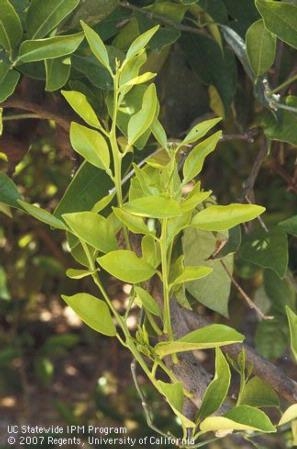
nitrogen deficiency

endoxerosis 4

boron toxicity citrus 1
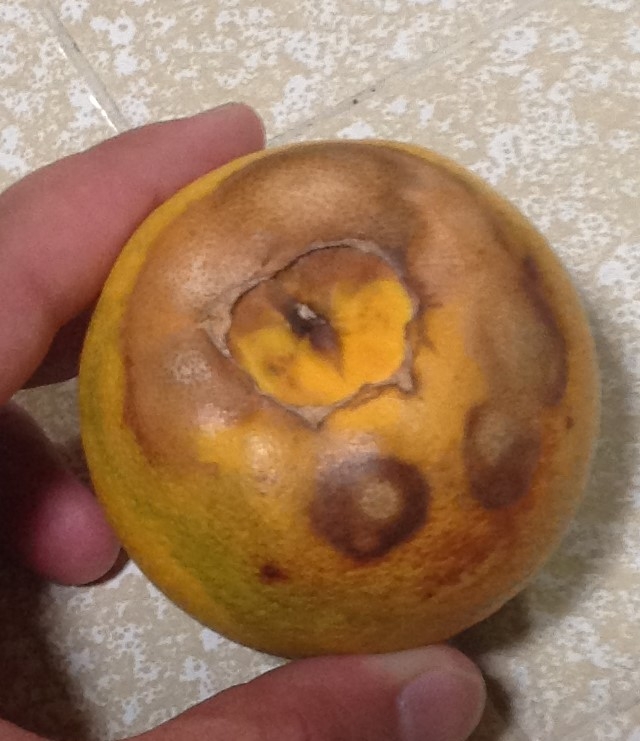
blossom end rot lemon

potassium deficiency avocado

gumming dothiorella

avocado black streak 1

bacterial canker avocado

citrus red mite

PSHB damage
Optimizing Leaching of Salts
Water moves in a wetting front. When irrigation water hits the soil it moves down with the pull of gravity and to the side according to the pull of soil particles (more lateral with more clay). Soil is a jumble of different sized soil particles, from clay to silt to sand sizes and then often intermixed with stones of different sizes from gravels to boulder. The different textures determine how water moves. It moves fastest through coarse textures and slowest through finer ones – the clays, the ones with the smallest pores. But soils are a jumble of particle sizes and pores.
Water first moves down the larger pores and then it slowly moves through the larger ones. As water moves through the soil it carries salts that have accumulated in the soil. At the wetting front is where the salt accumulate. As the water moves through the larger pores, salts migrate/diffuse from the small pores to the larger ones. This diffusion takes a bit of time, so typically the small pores have a larger salt concentration than the larger ones.
So an initial application of water will carry the salts from these large pores and if the irrigator were to stop in mid-application, it allows time for the salts to move out of the small pores into the larger ones. Then when the irrigation recommences, it will carry more of the salts out of the wetted area – the root zone. This technique is called “bumping” where an irrigation is stopped and then restarted in order to improve not only leaching, but also reduce runoff.
This principle also is at play when there are two or more sources of water quality. Soil salinity can be no lower than the irrigation water that is applied. Then as the soil water is removed through plant absorption or evaporation, the salinity increases. The soil salinity can easily be two to three times higher than the irrigation water.
If there are two sources of water, the initial application can be with the poorer quality water, and once that has reduced the soil salinity, then the better water quality can be applied which will then bring the soil salinity closer to that of the better quality water. By doing this two part leaching, the amount applied of the better quality water can be significantly reduced. This is a type of “bumping” to improve leaching.
Watch this U-Tube video on how water moves through soil, thanks to the work at Walla Walla Community College.
https://www.youtube.com/watch?feature=player_detailpage&v=J729VzBeI_g
Thank you Walla Walla Community College for the video

water movement
Avocados and Water
Avocados and Water
Avocados are the most salt and drought sensitive of our fruit tree crops. They are shallow rooted and are not able to exploit large volumes of soil and therefore are not capable of fully using stored rainfall. On the other hand, the avocado is highly dependent on rainfall for leaching accumulated salts resulting from irrigation water. In years with low rainfall, even well irrigated orchards will show salt damage. During flowering there can be extensive leaf drop due to the competition between flowers and leaves when there is salt/drought stress. In order to reduce leaf damage and retain leaves, an excess amount of water is required to leach salts out of the roots zone. The more salts in the water and the less rainfall, the greater leaching fraction.
Drought stress often leads to diseases, such as black streak, bacterial canker, and blight (stem, leaf, and fruit). Leaf blight (Figure 1) is often confused with salt or tip burn (Fig. 2), but is actually a fungal disease that forms an irregular dead pattern on leaves and leads to defoliation. Blight is associated with lack of water, while salt burn is due to poor quality water and poor irrigation habits. Leaf blight often shows up after Santa Ana conditions, when growers get behind on their irrigations and the root zone dries out suddenly. There has been a high incidence of this disease the last two years. In both cases, defoliation leads to sunburned trees and fruit which can be severe economic losses. The only way to prevent these conditions is to keep up with your irrigation schedule.
Irrigation Management
To get your water to go further, it is important that the system is tuned in order to get the best distribution uniformity (DU). Many of our systems were installed 40 years ago and old age can lead problems, such as clogging, broken emitters, mixed emitters that put out different amounts and leaks. With poor DU, some trees get too much water and others do not get enough. Even fairly new irrigation systems can have poor DU, especially after a harvest. Poor water pressure on our step slopes is probably our main problem. A DU of 80% means 10% of the emitters are putting out more than the average and 10% are putting out less. The irrigator to compensate for the under irrigated 10% will run the system 10% longer to make sure the under irrigated trees get enough and over irrigating 10% of the trees with 20% more water than they need. A call to the local Resource Conservation District office can get a free DU evaluation and recommendations that are usually pretty reasonable to follow.
Aside from improving DU, it is important to know when and how much water to apply. When to apply can be evaluated by the hand or feel method (https://nutrientmanagement.tamu.edu/content/tools/estimatingsoilmoisture.pdf) which is fast and cheap. Or it can be done by tensiometer, Watermark or some of the more expensive electronic sensors. But these tools only tell you when to irrigate, not how much. This can be done by turning the system on (once you have made sure you have a good DU) and over the period of the irrigation insert a piece of rebar into the soil to determine the depth of infiltration. The rod will go down as far as the soil is moist and stop when it hits dry dirt. When you have about two feet of infiltration you will know how long to run the system to get an appropriate amount of water. A typical loam usually takes about 150 gallons per tree to two feet. Another way to get an approximation of the amount to apply is to use the Irrigation Calculator at http://www.avocadosource.com/tools/IrrigationCalculator.asp.
Managing the Tree Canopy
Significantly pruning trees can reduce the amount of water transpired by the tree. Trees that are about 15 feet in height, can be pruned by half and they will use half the water. Massive 30 foot trees would need to have a major pruning to significantly reduce water use. In extreme drought conditions and for the long term welfare of the grove, large trees should be stumped (Figure 3) or scaffolded (Figure 4) and paint white to prevent sunburn. Scaffolding usually produces fruit much sooner than stumping, because retaining a significant part of the trunk and branches the tree does not exert as much energy to regrow and retains buds that have been under apical dominance for less time. When new shoots appear they should be headed back to force lateral branches which is where the flowers will form.
All the prunings should be chipped and left in the field. This will help conserve water and help control Phytophthora root rot. Root rot or crown rot trees should not be pruned until they have been brought to health with one of the phosphorous acid formulations. They all are effective. Pruning a sick redirects the trees energy to fighting off the disease when it starts pushing new growth and then does not have the energy to fight off the disease. Or if you do have areas that are diseased (sunblotch, root rot, crown rot, etc.), windblown, in shallow soils or areas of recurrent frost, you might just remove the trees completely to save water.
White kaolin (Surround) applied to leaves has been shown to reduce leaf temperatures and water loss. This can be used, but under the direction of the packing house, since it if it is applied to fruit, it is very difficult to remove.
These are some steps that a grower can take to improve water management and create a more efficient use of water to help survive this period of not knowing how long this drought will last.
Dothiorella gregaria." border="0" height="364" width="241">
Figure 1. Leaf blight is a disease that occurs with lack of water of any quality.
Figure 2. Salt damage from poor quality water and poor irrigation habits.
Figure 3. Stumped avocados for lack of water.
Figure 4. Scaffolded avocado that should produce fruit sooner than a stumped avocado.

Avocado leaf blight

avocado salt damage
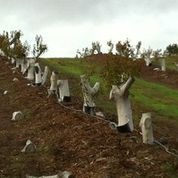
stumped avos 1
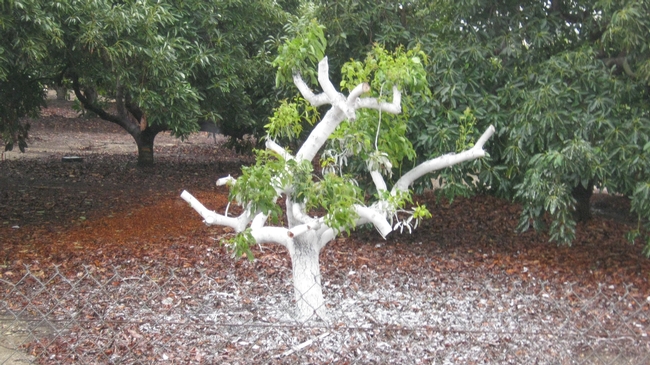
scaffolded avocado
